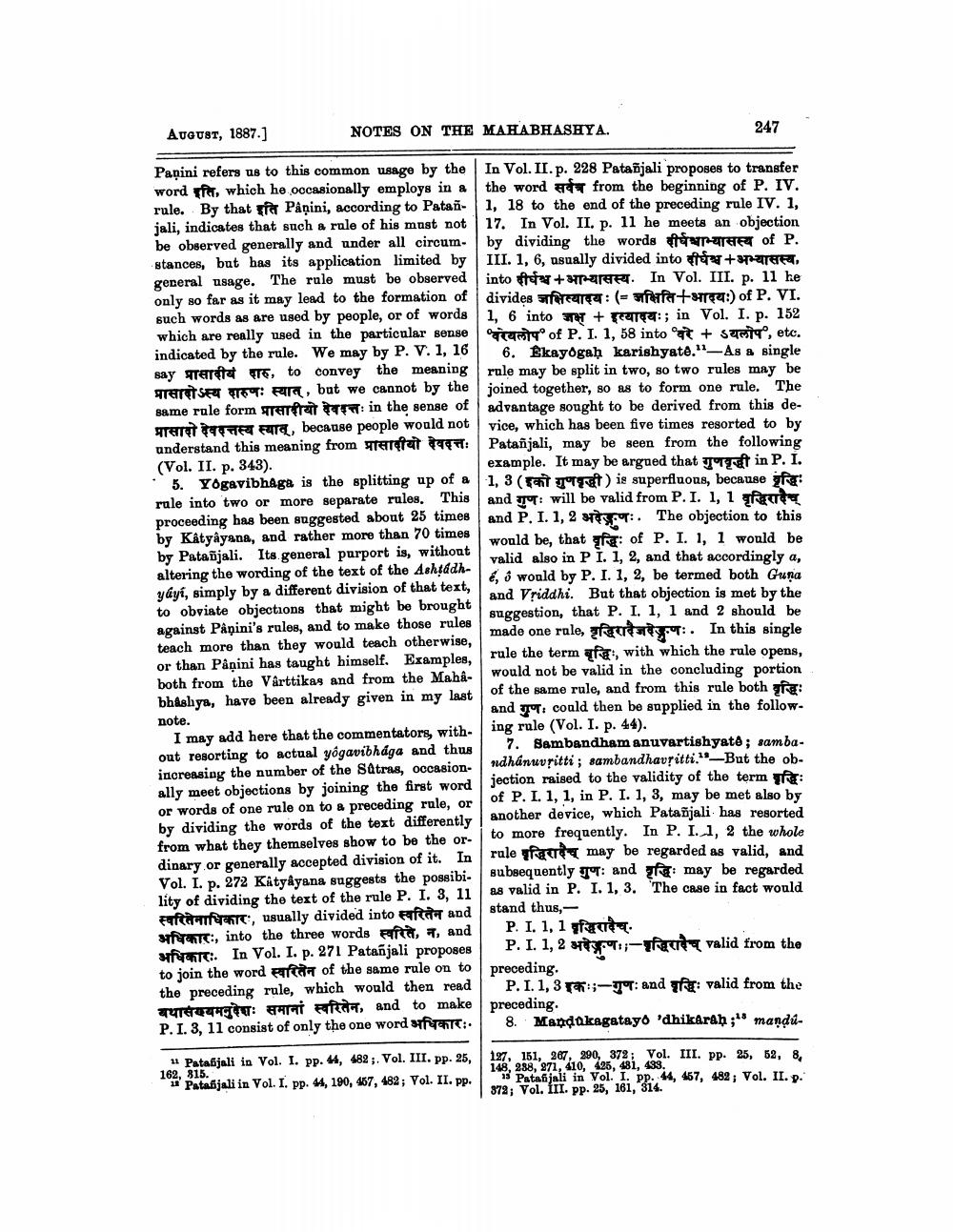________________
AUGUST, 1887.)
NOTES ON THE MAHABHASHYA.
247
Paņini refers us to this common usage by the In Vol. II. p. 228 Patañjali proposes to transfer wordt, which he occasionally employs in a the word from the beginning of P. IV. rule. By that for Påņini, according to Patañ- 1, 18 to the end of the preceding rule IV. 1, jali, indicates that such a role of his must not 17. In Vol. II. p. 11 he meets an objection be observed generally and under all circum- by dividing the words - He of P. stances, but has its application limited by III. 1, 6, asually divided into +12TER, general usage. The rule must be observed into + 32GR. In Vol. III. p. 11 he only so far as it may lead to the formation of divides freurger: (= sufert :) of P. VI. such words as are used by people, or of words 1,6 into TT + TUT:; in Vol. I. p. 152 which are really used in the particular sense Um of P. I. 1, 58 into + + S ', etc. indicated by the rule. We may by P. V. 1, 16 6. Ekayogaḥ karishyate."- As a single say serta To, to convey the meaning rule may be split in two, so two rules may be arerSET : Rir, but we cannot by the joined together, so as to form one rule. The same rule form ofret : in the sense of advantage sought to be derived from this deप्रासादो देवदत्तस्य स्यात्, because people would not vice, which has been five times resorted to by understand this meaning from प्रासादीयो देवदत्तः Patañjali, may be seen from the following (Vol. II. p. 343).
example. It may be argued that Turret in P. I. 5. Yogavibhaga is the splitting up of a 1, 3 ( Trat) is superfluons, because of rule into two or more separate rules. This and T will be valid from P. I. 1, 1 egg proceeding has been suggested about 25 times and P. I. 1, 2 y . The objection to this by Kâtyâyana, and rather more than 70 times
would be, that her of P. I. 1, 1 would be by Patañjali. Its general purport is, without
valid also in P I. 1, 2, and that accordingly a, altering the wording of the text of the Ashtadh
, would by P. I. 1, 2, be termed both Guna yáyi, simply by a different division of that text,
and Vriddhi. But that objection is met by the to obviate objections that might be brought
suggestion, that P. I. 1, 1 and 2 should be against Panini's rules, and to make those rules
made one rule, grg . In this single teach more than they would teach otherwise, or than Påņini has taught himself. Examples,
rule the term afas, with which the rule opens, both from the Vårttikas and from the Maha
would not be valid in the concluding portion
of the same rule, and from this rule both gre: bhashya, have been already given in my last
and your could then be supplied in the follownote. I may add here that the commentators, with
ing rule (Vol. I. p. 44). out resorting to actual yogavibhága and thus
7. Sambandham anuvartishyatd; sambaincreasing the number of the Satras, occasion
ndhanuvritti; sambandhavșitti."-But the ob
jection raised to the validity of the term ally meet objections by joining the first word
of P. I. 1, 1, in P. I. 1, 3, may be met also by or words of one rule on to a preceding rule, or
another device, which Patañjali has resorted by dividing the words of the text differently from what they themselves show to be the or
to more frequently. In P. I. 1, 2 the whole dinary or generally accepted division of it. In
rale afgrey may be regarded as valid, and Vol. I. p. 272 Kätyâyana suggests the possibi
subsequently 1: and gre may be regarded lity of dividing the text of the rule P. I. 3, 11
as valid in P. I. 1, 3. "The case in fact would Faftara c, usually divided into rifat and stand thus, अधिकारः, into the three words स्वरिते, न, and | P. I. 1, 1 aface.
T:. In Vol. I. p. 271 Patañjali proposes P. I. 1, 2 ;-fact valid from the to join the word Rifan of the same rule on to preceding. the preceding rule, which would then read P. I. 1, 3 *::--TT: and are valid from the TUTUSTU: HARI RIGA, and to make preceding. P. I. 3, 11 consist of only the one word of TT:. 8. Mandakagatayo 'dhikaraḥ ;'* mandu
11 Patañjali in Vol. I. pp. 44, 482;. Vol. III. pp. 25, 162, 815.
* Patabijali in Vol. I. pp. 44, 190, 467, 482 ; Vol. II. pp.
127, 151, 207, 200, 372; Vol. III. pp. 25, 52, 8, 148, 288, 271, 410, 425, 481, 433.
13 Patanjali in Vol. 1. pp. 44, 457, 482; Vol. II. p. 372; Vol. III. pp. 25, 161, 314.




